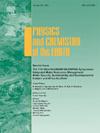印度喜马拉雅山的雪崩:印度喜马偕尔邦Kullu地区的危险区和气候变化趋势
IF 4.1
3区 地球科学
Q2 GEOSCIENCES, MULTIDISCIPLINARY
引用次数: 0
摘要
本研究对印度喜马拉雅地区的雪崩行为进行了深入的分析,特别是针对Kullu地区。该研究整合了气候数据、地形特征和实地验证,应用基于目标的图像分割(OBIS)分析,以实现更精确的灾害区划。在过去的几十年里,该地区经历了雪崩频率和强度的显著增加,这些变化与气温上升、降水模式改变等气候因素以及基础设施发展等人为影响有关。该研究强调了气象变量(包括雪温、风速等)与地形特征之间复杂的相互作用对雪崩易感性的影响。OBIS在实地调查和文献的支持下,可以精确识别高危雪崩区,显著增强预测模型。研究结果还显示,气候变化趋势预计将扩大未来雪崩发生的频率和规模,对当地人口、基础设施和该地区的生物多样性构成更大的风险。该研究通过系统地确定易发生雪崩的地区和分析气候变化预测,为制定强有力的风险管理和气候适应战略提供了重要见解。这些战略对于保护脆弱的山区社区和生态系统至关重要。这项研究的更广泛意义超出了印度喜马拉雅山脉,有助于全球了解雪崩动力学,并强调需要在高海拔地区建立全面的气候适应和减少灾害风险框架。本文章由计算机程序翻译,如有差异,请以英文原文为准。
Snow avalanche in the Indian Himalayas: Hazard zonation and climate change trends in Kullu region of Himachal Pradesh, India
This research provides an in-depth analysis of snow avalanche behavior in the Indian Himalayas, specifically targeting the Kullu region. The study integrates climate data, terrain characteristics and field validations to apply Object-Based Image Segmentation (OBIS) analysis for more precise hazard zonation. Over the past few decades, the region has experienced a notable increase in avalanche frequency and intensity, correlating these changes with climatic factors such as rising temperatures, altered precipitation patterns, and anthropogenic influences like infrastructure development. The study emphasizes the complex interplay between meteorological variables—including snow temperature, wind speed etc. and the topographical features contributing to avalanche susceptibility. OBIS, supported by field surveys and literature, allows for a refined identification of high-risk avalanche zones, significantly enhancing prediction models. The findings also reveal that climate change trends are expected to amplify the frequency and magnitude of avalanche occurrences in the future, posing heightened risks to local populations, infrastructure and the region's biodiversity. The study contributes critical insights for developing robust risk management and climate adaptation strategies by systematically identifying avalanche-prone areas and analysing climate change projections. These strategies are essential for safeguarding vulnerable mountain communities and ecosystems. The broader implications of this research extend beyond the Indian Himalayas, contributing to the global understanding of avalanche dynamics and highlighting the need for comprehensive climate adaptation and disaster risk reduction frameworks in high-altitude regions.
求助全文
通过发布文献求助,成功后即可免费获取论文全文。
去求助
来源期刊

Physics and Chemistry of the Earth
地学-地球科学综合
CiteScore
5.40
自引率
2.70%
发文量
176
审稿时长
31.6 weeks
期刊介绍:
Physics and Chemistry of the Earth is an international interdisciplinary journal for the rapid publication of collections of refereed communications in separate thematic issues, either stemming from scientific meetings, or, especially compiled for the occasion. There is no restriction on the length of articles published in the journal. Physics and Chemistry of the Earth incorporates the separate Parts A, B and C which existed until the end of 2001.
Please note: the Editors are unable to consider submissions that are not invited or linked to a thematic issue. Please do not submit unsolicited papers.
The journal covers the following subject areas:
-Solid Earth and Geodesy:
(geology, geochemistry, tectonophysics, seismology, volcanology, palaeomagnetism and rock magnetism, electromagnetism and potential fields, marine and environmental geosciences as well as geodesy).
-Hydrology, Oceans and Atmosphere:
(hydrology and water resources research, engineering and management, oceanography and oceanic chemistry, shelf, sea, lake and river sciences, meteorology and atmospheric sciences incl. chemistry as well as climatology and glaciology).
-Solar-Terrestrial and Planetary Science:
(solar, heliospheric and solar-planetary sciences, geology, geophysics and atmospheric sciences of planets, satellites and small bodies as well as cosmochemistry and exobiology).
 求助内容:
求助内容: 应助结果提醒方式:
应助结果提醒方式:


